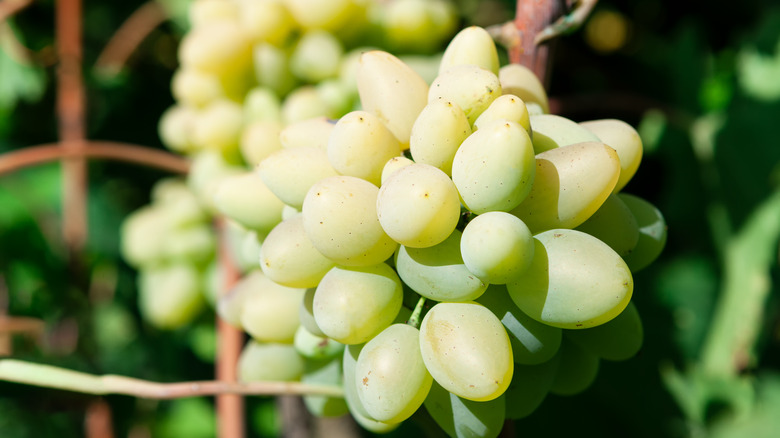Why You'll Probably Never See Cotton Candy Grape Wine
Here at Tasting Table, we're all about a good recipe, but we know that wine isn't just for cooking. From Alberiño to Piedmont, our favorite glasses vary across a wide spectrum, and the thing that separates one wine from another is the type of grapes it comes from. According to VinePair, Moscato is made from the Muscat grape. Merlot and Cabernet Sauvignon grapes are often grown and blended to make many of the red wines that line enoteca aisles. Some wines, like Burgundy, Bordeaux, and Chianti, are named after the geographical region of the world in which their grapes grow. (Contrary to its namesake, some rosés are made from pinot noir grapes.)
However, there's one particular avante-garde grape variety we need to discuss: cotton candy grapes. Per NPR, cotton candy grapes are a hybrid specie created by cross-pollinating grape plants — no genetic engineering included. (And they taste exactly like their namesake.) They were created by horticulturalists David Cain and the experts at International Fruit Genetics in Bakersfield, California, and first hit the market in 2011. The public reception for this candy-like grape has reportedly been steadily growing ever since — and with 12% higher sugar content than your average table grapes (18 grams of sugar for every 100 grams total), of course, folks are digging it. Although, there is one drawback for oenophiles: You'll probably never see cotton candy grape wine. Here's why.
Pricey and flat... not sweet
According to Cain, via Per NPR, cotton candy grapes don't simply grow on vines. To generate growth, scientists have to extract the embryos from baby grape hybrids and fertilize them in test tubes. It probably won't come as much of a surprise, then, that they're notoriously expensive. At a Whole Foods Market in Brooklyn, cotton candy grapes run for $4.99 per pound, compared to $1.99 per pound for red seedless grapes. But the high cost of production isn't the only reason this wine will probably never happen.
In 2016, Jim Beagle, CEO and co-founder of Grapery, said some grape farmers tried making cotton candy grape wine via Bon Appétit — and it was a disaster. As Beagle puts it, "It's so bad. It tastes nothing like cotton candy... no acidity structure to give you [a] balanced mouthfeel. It tastes like the flabbiest Chardonnay you've ever had. And it smells like stale donuts." Scientifically, this feedback makes sense. Most wine grapes belong to the "Vitus vinifera" grape species, says Cain, but cotton candy grapes are a hybrid specie of V. vinifera and a yet-undisclosed Concord-adjacent specie. Therefore, not only do cotton candy grapes taste super unique, but they're also fundamentally different from other grapes at a biological level. So, perhaps cotton candy grapes should remain the super-sweet superstar of the fruit bowl and leave wine-making to the others. (If you're super into the idea, luckily, cotton candy-flavored dessert wine is still a thing.)

